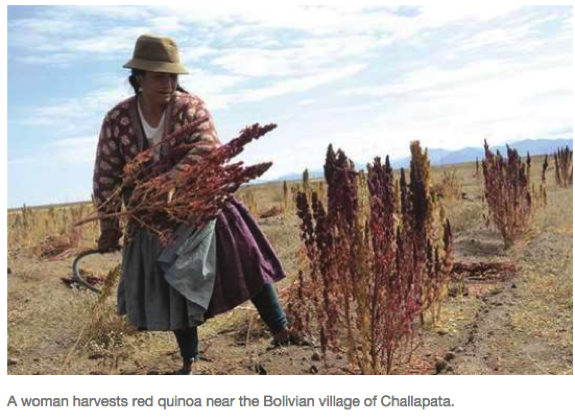
Quinoa boom has disastrous consequences for Bolivian farmers
August 6, 2017 - Gulf News
It's market day in Challapata, a small village in the mountains of western Bolivia. A few vendors are setting themselves up on a gravelled area the size of two football pitches, with the snow-covered Andes in the background.
A couple of years ago, this market would have been teeming with sellers and their sacks of black, yellow and red quinoa. But not any more.
The residents of Challapata though they'd hit the jackpot with quinoa, a grain traditionally grown here and whose price has exploded in recent years – but in Challapata, there's not much of the boom left to be seen.
The traditional farmers here can't compete with their bigger rivals, who rely heavily on pesticides, and whose increased production has led to a drastic fall in prices.
Also known as "the gold of the Incas," quinoa is the seed of the Chenopodium quinoa and because of its alleged nutritional values, has been lauded as a "superfood."
Until relatively recently it was only really eaten by the indigenous peoples of the Andes, in places like Challapata, which is 3,800 metres above sea level.
But in recent years it has become fashionable in the West too, partly because of the success of Peruvian cooking abroad. The United Nations declared 2013 the "International Year of Quinoa."
When Bolivia's President Evo Morales takes trips in his government jet, he likes to snack on quinoa bars. And the craze has also brought forth products like quinoa shampoo.
Worldwide production has soared from 60,000 tonnes ten years ago to 250,000 tonnes. For a while, quinoa drove growth in Bolivia – but that soon started to change. Instead of the 6,000 dollars per tonne that Bolivia was raking in at its high point, it now only gets around 2,500 dollars.
"When the prices kept going up, we ate chips at home instead of quinoa so that we could sell more," says 29-year-old farmer German Velarde.
He has four children to feed, but only earns 700 bolivianos (100 dollars) a week. "Others are raking in the dollars but it's not real, good quinoa," he says.
The story of quinoa is one typical of globalisation. Suddenly, a product gains in popularity and its seeds are manipulated to make them adapt to other environments.
In Bolivia, indigenous peoples have been growing quinoa by hand and without pesticides for hundreds of years. But Peru has now overtaken Bolivia as the market leader, and farmers there are growing quinoa in industrial quantities. Indeed, quantity, not quality, is the order of the day.
Three years ago, Bolivian farmers were earning 1,500 bolivianos (217 dollars) for a sack weighing 46 kilos. Now, they can only hope for 320 bolivianos (46 dollars). By contrast, 500 grams of organic quinoa in a US supermarket will set you back about 4 dollars.
Quinoa is now also being farmed in the United States, India and China. Because of the drop in prices and because of drought, production in Bolivia plunged from 89,000 tonnes to 69,000 tonnes last year, following six years of growth.
Around 200 of the country's 2,000 quinoa farmers have given up, according to Benjamin Martinez, president of the Bolivian quinoa farmers' association.
Back in the market place, Julian Canavari has travelled 80 kilometres to Challapata with his girlfriend Matilde Duran to sell three sacks of quinoa. "They were golden times, 2013, 2014," he says. "I bought my first ever car with the money." Today, he barely manages to pay for the petrol.
"In Peru they're farming modified quinoa in order to increase production, which destroys the prices," says Canavari, frowning. "In Europe, nobody knows that quinoa isn't necessarily quinoa. It would be much better for us if we could sell directly to retailers there."
Pointing to the nearby quinoa fields, he adds, "A few years ago there was only quinoa here. Now some are switching back to grains and clover for cattle."
On the drive home, Canavari stops to chat to a farmer and his wife, who are harvesting red quinoa with sickles. They talk about the fall in prices, and Canavari gives them a couple of coca leaves to chew on – it stops people feeling so tired.
Around 460 grams of coca leaves cost 40 bolivianos, while the same amount of quinoa costs just 3.20 bolivianos – another indication of the problems the local farmers face.
Canavari's 30 hectares of quinoa soon won't be worth keeping any more. "If it carries on like this we'll have to move away to the city, to Oruro or La Paz," he says. - DPA